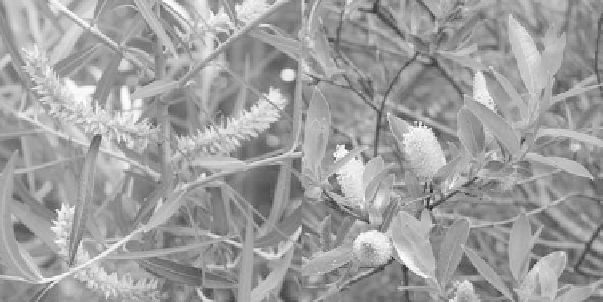Environmental Engineering Reference
In-Depth Information
Willows are a pioneer species that can tolerate many types of harsh growing conditions and they
demand full sunlight. In North America, willows were among the initial colonizers of the wet and
gravelly sites left by the recession of glaciers 12,000-13,000 years ago (Hardig et al. 2000). Now
they generally occupy lowland and poorly drained sites, including the shorelines of rivers, lakes,
and creeks, wetlands, and some upland sites where they may outcompete other shade-intolerant
species. Members of the genus
Salix
are deciduous and perennial, most with a remarkable ability
to continue growing until a severe frost in the fall because they do not form a terminal vegetative
bud. Individual plants have a typical life span of 20-60 years, although some willow shrubs have
been grown in nursery stool beds for over 100 years. This longevity often depends on the harvesting
or removal of aged stems, which then stimulates the growth of new shoots from buds that emerge
from the stool or root crown. Even in situations of extreme defoliation from pests or stem dieback
from frost, buds will rapidly break their dormancy and replenish the plant with photosynthetically
productive foliage. For most species of willow, when a piece of stem is submerged in water or stuck
into moist soil, it can readily produce roots, allowing for the establishment of a new, genetically
identical plant and further extending the effective life span of that genet. There is evidence that
some populations of
S. purpurea
in New York State have become established strictly through clonal
propagation (Lin et al. 2009). Some willow species (e.g., those in the subgenus
Longifoliae
) can
produce new plants by root suckering, although this trait has been avoided in the selection of species
or varieties to be cultivated for bioenergy production because these plants rapidly spread from the
site of the original planting.
All
Salix
are dioecious, meaning that an individual plant produces only male or only female
flowers (Figure 28.1). For most species, floral buds are set in late summer or early fall on the
distal portions of the shoots and break dormancy early in the spring, maturing to form catkins
with several dozen individual flowers each. Although plants established from cuttings may form
floral buds by the end of the first growing season, flower production is much more prevalent after
the second growing season. Plants established from seed usually do not produce flowers until the
second growing season. Cross-pollination is accomplished by both insects—usually bees—and
wind, depending on the weather conditions (Argus 1974; Tamura and Kudo 2000; Karrenberg
et al. 2002a, 2002b). Once pollinated, the females produce many dozens of seeds for each catkin.
The pistil swells to form a capsule, which bursts open when dry and mature to release the seeds
to the wind for dispersal—each covered with cottony hairs. These cottony hairs aid the seeds in
floating and eventually settling on a suitable substrate for establishment, such as wet sand (Gage and
Cooper 2005; Seiwa et al. 2008). Willow seed has strict establishment criteria, and the seeds have a
very short life span, resulting in a relatively low rate of successful establishment of the annual seed
production for a pioneer species and no seed bank (Karrenberg et al. 2002a, 2002b; Karrenberg and
FIGure 28.1
Examples of male and female willow flowers. Female catkins produced by
S. viminalis
(left panel) and male catkins of
S. lucida
(right panel).

